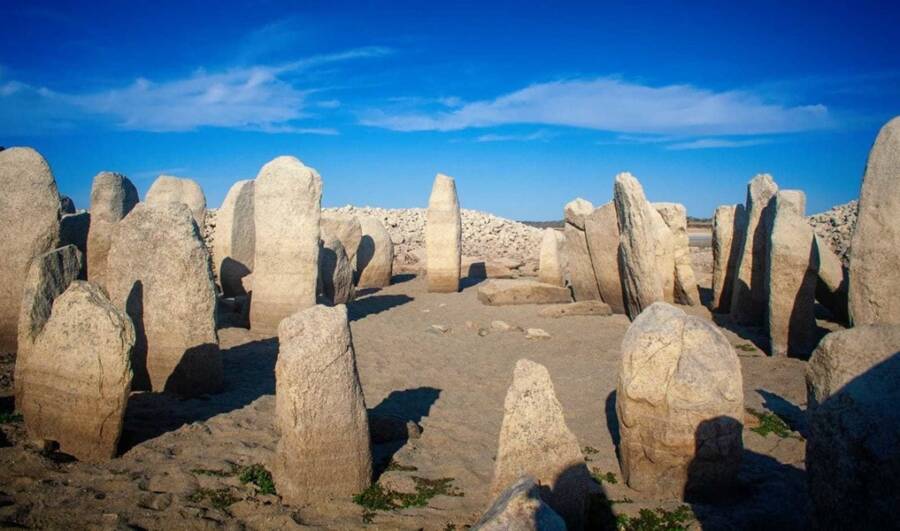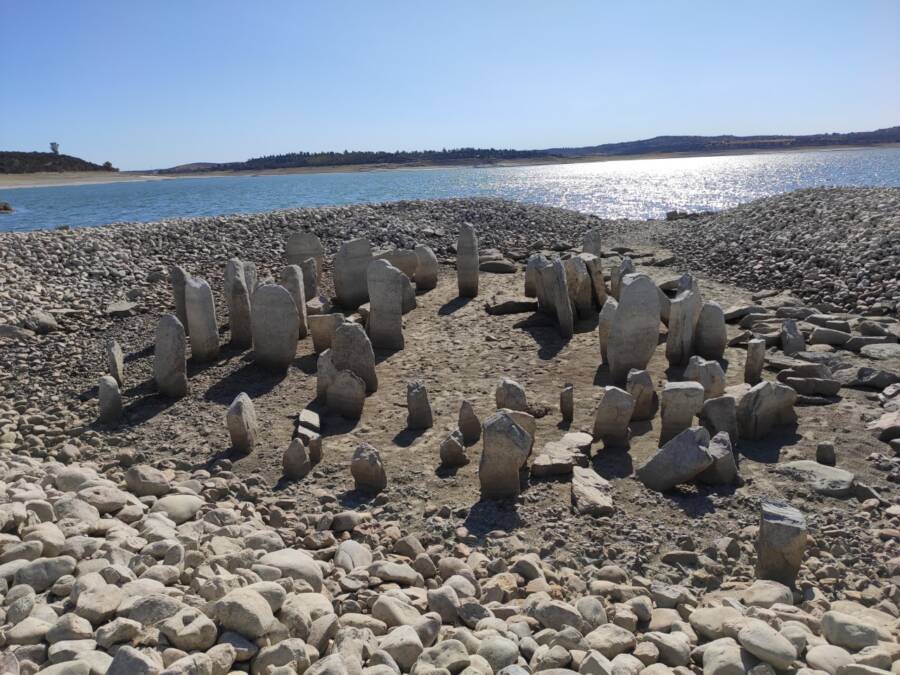"I had seen parts of it peeking out from the water before, but this is the first time I've seen it in full."

Ruben Ortega Martin/Raices de PeraledaThe Dolmen de Guadalperal, also known as the “Spanish Stonehenge,” has been completely exposed for the first time in 50 years following the drought.
Severe changes in weather, particularly across Europe, have been a curse for farmers whose crops are suffering and who are losing millions of euros because of it. But for archaeologists, these severe changes sometimes help them gain access to relics that were previously out of reach.
Take Spain’s 7,000-year-old Dolmen de Guadalperal, a megalithic monument made up of 144 standing stones — some up to six feet tall — arranged in a circular open space. Located in the province of Cáceres, this previously-underwater monument has now been completely exposed following the harsh drought that has hit the area.
Often referred to as the “Spanish Stonehenge” thanks to certain similarities with the original in England, this structure has now appeared for the first time in 50 years.
“I had seen parts of it peeking out from the water before, but this is the first time I’ve seen it in full,” said Angel Castaño, president of the local cultural association, as quoted in Atlas Obscura.
“It’s spectacular because you can appreciate the entire complex for the first time in decades.”

Wikimedia Commons
As a resident of Peraleda de la Mata, a village just a couple miles from the dolmen’s location, Castaño has been familiar with the ancient structure all his life. Yet, this is the first time he has been able to truly appreciate its magnificence.
The Dolmen de Guadalperal was not always submerged underwater. The area around Cáceres was still dry when the monument was first uncovered by German archaeologist Hugo Obermaier, who led an excavation of the site in the mid-1920s. It wasn’t until four decades later that Obermaier’s paper about the ancient structure was finally published.
The archaeological site, for the most part, remained undisturbed until the Spanish government wanted to build a dam and reservoir right around it. Construction of the Valdecañas Reservoir flooded the area and submerged the historical stones in water in 1963.

1080 Wildlife ProductionsThe Dolmen de Guadalperal from above. Archaeologists hope to get the ancient structure moved before it is flooded again.
If water were to drown an entire archaeological site today, there would most certainly be an immediate backlash from historians and researchers, which is currently happening with the soon-to-be flooded historical site of Hasankeyf. But back then, the dolmen’s flooding was simply accepted.
Primitiva Bueno Ramirez, a specialist in prehistory at the University of Alcalá, explained that the importance of archaeological studies back then weren’t as appreciated as they are now, and there was no standard practice for creating environmental reports before such a massive project was greenlit.
“You couldn’t believe how many authentic archaeological and historic gems are submerged under Spain’s man-made lakes,” Ramirez said.
The re-emergence of the Dolmen de Guadalperal has no doubt excited archaeologists, who believe that the stones in the structure were transported from three miles away on the banks of the Tagus River, the longest waterway in the Iberian Peninsula, sometime in the fifth millennium BC. It was meant as a burial place and a temple to worship the sun.
Scientists believe that, though its current shape appears to be that of an open-air, unfinished circle, the monument was once entirely enclosed, complete with a roof on top.
According to Ramirez, people would have entered through a narrow hallway adorned with engravings and other decorations to access the original structure. The hallway would lead into a more spacious main chamber that was 16 feet across, where the dead were likely kept.

JMN/Cover/Getty ImagesFlourishing crops in the Cáceres province of Spain before the drought.
He also said that it is likely the monument was oriented around the summer solstice, allowing the sun to shine upon the community’s buried ancestors.
Now that the Dolmen de Guadalperal has resurfaced, Castaño and his organization are hoping to get the monument permanently moved to a higher, drier place so that the structure doesn’t suffer more damage to its already eroding surface.
At its current location, the dolmen stands a few dozen yards away from the manmade lake. Time is of the essence as the drought is suspected to be temporary, meaning that the ancient structure could get drowned again in a month.
“Whatever we do here, needs to be done extremely carefully, Ramirez said. “We need high-quality studies using the latest archaeological technology. It may cost money, but we already have one of the most difficult things to obtain—this incredible historic monument. In the end, money is the easy part. The past can’t be bought.”
Next, explore the wonders of Gobekli Tepe, the world’s oldest temple — built 6,000 years before Stonehenge. Then, read all about the Georgia Guidestones, “America’s Stonehenge.”






